engine coolant YAMAHA TRACER 900 GT 2021 Owners Manual
[x] Cancel search | Manufacturer: YAMAHA, Model Year: 2021, Model line: TRACER 900 GT, Model: YAMAHA TRACER 900 GT 2021Pages: 116, PDF Size: 4.35 MB
Page 6 of 116
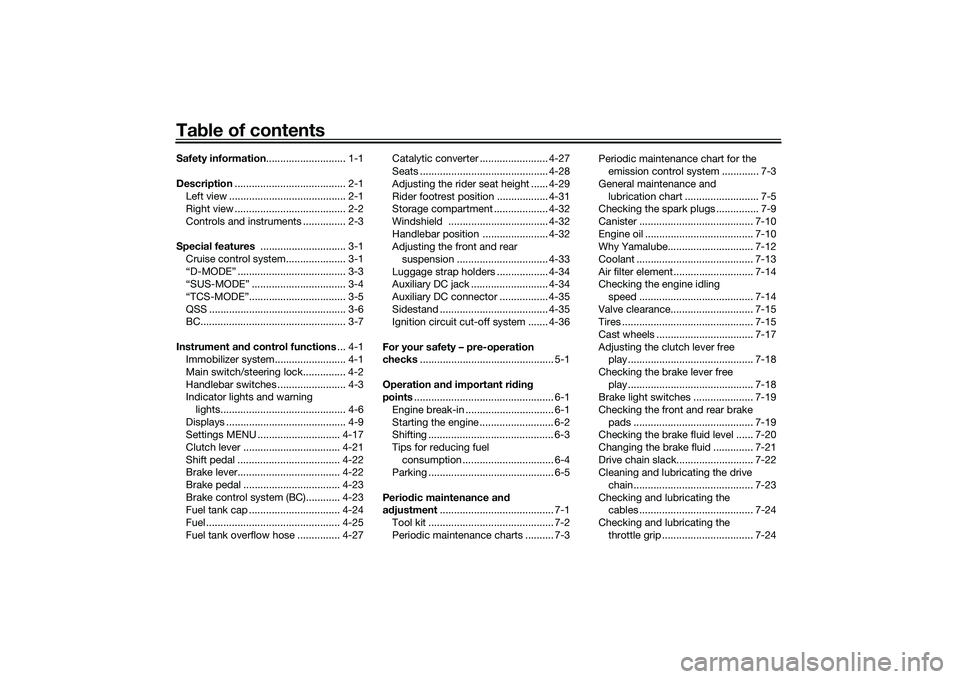
Table of contentsSafety information ............................ 1-1
Description ....................................... 2-1
Left view ......................................... 2-1
Right view ....................................... 2-2
Controls and instruments ............... 2-3
Special features .............................. 3-1
Cruise control system..................... 3-1
“D-MODE” ...................................... 3-3
“SUS-MODE” ................................. 3-4
“TCS-MODE”.................................. 3-5
QSS ................................................ 3-6
BC................................................... 3-7
Instrument an d control functions ... 4-1
Immobilizer system......................... 4-1
Main switch/steering lock............... 4-2
Handlebar switches ........................ 4-3
Indicator lights and warning
lights............................................ 4-6
Displays .......................................... 4-9
Settings MENU ............................. 4-17
Clutch lever .................................. 4-21
Shift pedal .................................... 4-22
Brake lever.................................... 4-22
Brake pedal .................................. 4-23
Brake control system (BC)............ 4-23
Fuel tank cap ................................ 4-24
Fuel ............................................... 4-25
Fuel tank overflow hose ............... 4-27 Catalytic converter ........................ 4-27
Seats ............................................. 4-28
Adjusting the rider seat height ...... 4-29
Rider footrest position .................. 4-31
Storage compartment ................... 4-32
Windshield ................................... 4-32
Handlebar position ....................... 4-32
Adjusting the front and rear
suspension ................................ 4-33
Luggage strap holders .................. 4-34
Auxiliary DC jack ........................... 4-34
Auxiliary DC connector ................. 4-35
Sidestand ...................................... 4-35
Ignition circuit cut-off system ....... 4-36
For your safety – pre-operation
checks ............................................... 5-1
Operation an d important ri din g
points ................................................. 6-1
Engine break-in ............................... 6-1
Starting the engine .......................... 6-2
Shifting ............................................ 6-3
Tips for reducing fuel consumption ................................ 6-4
Parking ............................................ 6-5
Perio dic maintenance an d
a d justment ........................................ 7-1
Tool kit ............................................ 7-2
Periodic maintenance charts .......... 7-3 Periodic maintenance chart for the
emission control system ............. 7-3
General maintenance and lubrication chart .......................... 7-5
Checking the spark plugs ............... 7-9
Canister ........................................ 7-10
Engine oil ...................................... 7-10
Why Yamalube.............................. 7-12
Coolant ......................................... 7-13
Air filter element ............................ 7-14
Checking the engine idling
speed ........................................ 7-14
Valve clearance............................. 7-15
Tires .............................................. 7-15
Cast wheels .................................. 7-17
Adjusting the clutch lever free play ............................................ 7-18
Checking the brake lever free play ............................................ 7-18
Brake light switches ..................... 7-19
Checking the front and rear brake
pads .......................................... 7-19
Checking the brake fluid level ...... 7-20
Changing the brake fluid .............. 7-21
Drive chain slack........................... 7-22
Cleaning and lubricating the drive
chain.......................................... 7-23
Checking and lubricating the cables ........................................ 7-24
Checking and lubricating the throttle grip ................................ 7-24UBAPE0E0.book Page 1 Thursday, December 24, 2020 9:14 AM
Page 14 of 116

Description
2-2
2
EAU10421
Right view
6
74
5
2
1
3
1. Fuel tank cap (page 4-24)
2. Spring preload adjuster (page 4-33)
3. Coolant reservoir (page 7-13)
4. Engine oil level check window (page 7-10)
5. Engine oil filler cap (page 7-10)
6. Brake pedal (page 4-23)
7. Rear brake fluid reservoir (page 7-20)UBAPE0E0.book Page 2 Thursday, December 24, 2020 9:14 AM
Page 30 of 116
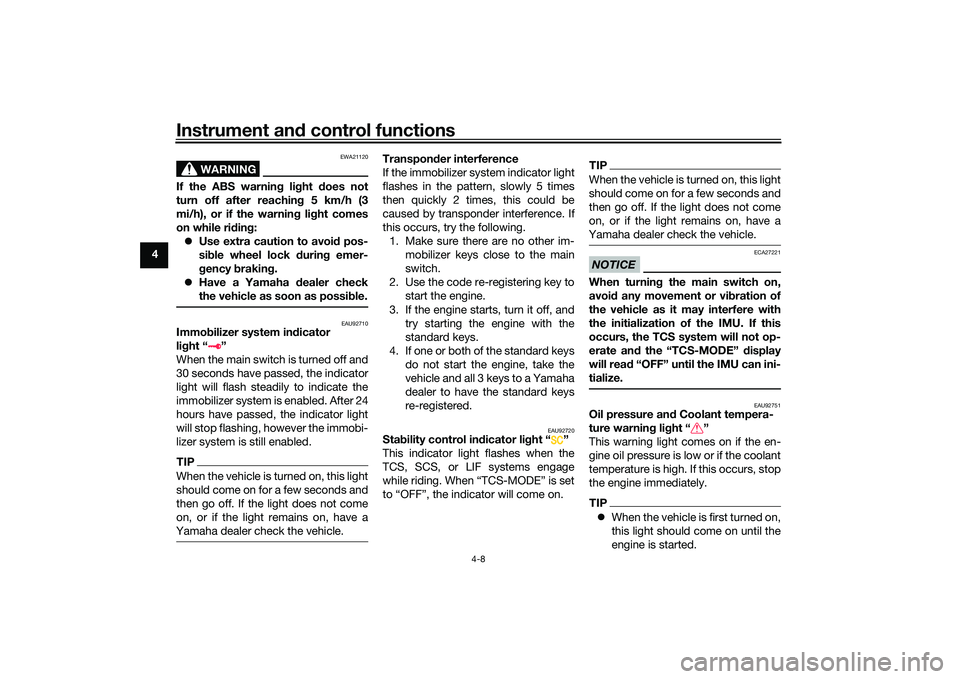
Instrument and control functions
4-8
4
WARNING
EWA21120
If the ABS warnin g lig ht does not
turn off after reachin g 5 km/h (3
mi/h), or if the warnin g li ght comes
on while rid ing:
Use extra caution to avoi d pos-
si ble wheel lock d uring emer-
g ency brakin g.
Have a Yamaha dealer check
the vehicle as soon as possi ble.
EAU92710
Immo bilizer system in dicator
li g ht “ ”
When the main switch is turned off and
30 seconds have passed, the indicator
light will flash steadily to indicate the
immobilizer system is enabled. After 24
hours have passed, the indicator light
will stop flashing, however the immobi-
lizer system is still enabled.TIPWhen the vehicle is turned on, this light
should come on for a few seconds and
then go off. If the light does not come
on, or if the light remains on, have a
Yamaha dealer check the vehicle.
Transpon der interference
If the immobilizer system indicator light
flashes in the pattern, slowly 5 times
then quickly 2 times, this could be
caused by transponder interference. If
this occurs, try the following. 1. Make sure there are no other im- mobilizer keys close to the main
switch.
2. Use the code re-registering key to start the engine.
3. If the engine starts, turn it off, and try starting the engine with the
standard keys.
4. If one or both of the standard keys do not start the engine, take the
vehicle and all 3 keys to a Yamaha
dealer to have the standard keys
re-registered.
EAU92720
Sta bility control in dicator li ght “ ”
This indicator light flashes when the
TCS, SCS, or LIF systems engage
while riding. When “TCS-MODE” is set
to “OFF”, the indicator will come on.
TIPWhen the vehicle is turned on, this light
should come on for a few seconds and
then go off. If the light does not come
on, or if the light remains on, have a
Yamaha dealer check the vehicle.NOTICE
ECA27221
When turnin g the main switch on,
avoi d any movement or vi bration of
the vehicle as it may interfere with
the initialization of the IMU. If this
occurs, the TCS system will not op-
erate an d the “TCS-MODE” display
will rea d “OFF” until the IMU can ini-
tialize.
EAU92751
Oil pressure an d Coolant tempera-
ture warnin g lig ht “ ”
This warning light comes on if the en-
gine oil pressure is low or if the coolant
temperature is high. If this occurs, stop
the engine immediately.TIP When the vehicle is first turned on,
this light should come on until the
engine is started.
UBAPE0E0.book Page 8 Thursday, December 24, 2020 9:14 AM
Page 31 of 116
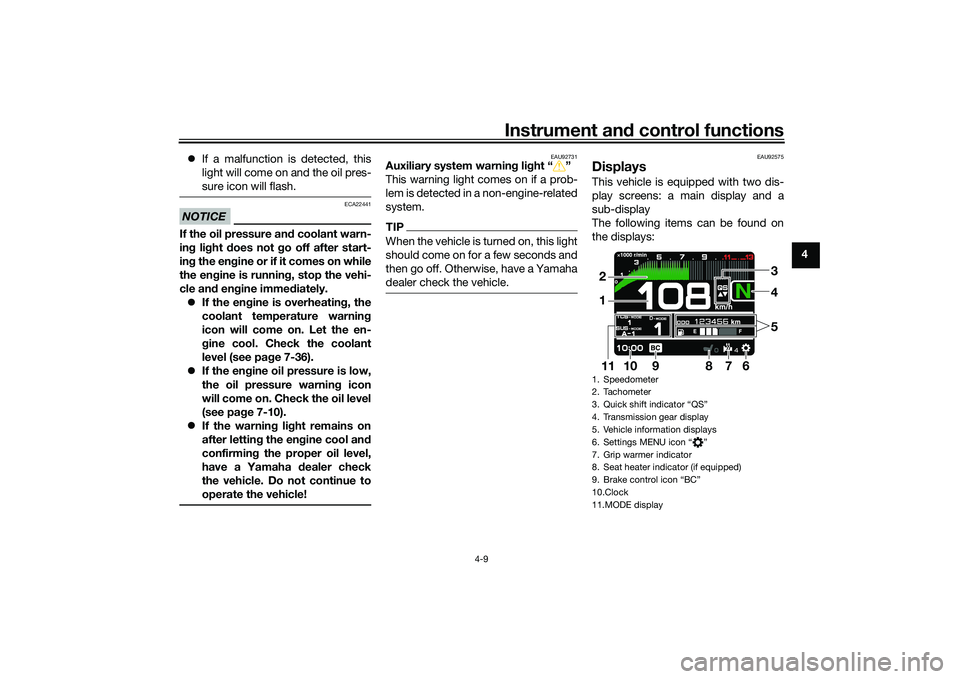
Instrument and control functions
4-9
4
If a malfunction is detected, this
light will come on and the oil pres-
sure icon will flash.
NOTICE
ECA22441
If the oil pressure an d coolant warn-
in g li ght does not go off after start-
in g the en gine or if it comes on while
the en gine is runnin g, stop the vehi-
cle an d en gine imme diately.
If the en gine is overheatin g, the
coolant temperature warnin g
icon will come on. Let the en-
g ine cool. Check the coolant
level (see pa ge 7-36).
If the en gine oil pressure is low,
the oil pressure warnin g icon
will come on. Check the oil level
(see pa ge 7-10).
If the warnin g lig ht remains on
after lettin g the en gine cool an d
confirmin g the proper oil level,
have a Yamaha dealer check
the vehicle. Do not continue to
operate the vehicle!
EAU92731
Auxiliary system warnin g lig ht “ ”
This warning light comes on if a prob-
lem is detected in a non-engine-related
system.TIPWhen the vehicle is turned on, this light
should come on for a few seconds and
then go off. Otherwise, have a Yamaha
dealer check the vehicle.
EAU92575
DisplaysThis vehicle is equipped with two dis-
play screens: a main display and a
sub-display
The following items can be found on
the displays:1. Speedometer
2. Tachometer
3. Quick shift indicator “QS”
4. Transmission gear display
5. Vehicle information displays
6. Settings MENU icon “ ”
7. Grip warmer indicator
8. Seat heater indicator (if equipped)
9. Brake control icon “BC”
10.Clock
11.MODE display
4
7
6
1011
12
9
35
8
UBAPE0E0.book Page 9 Thursday, December 24, 2020 9:14 AM
Page 32 of 116
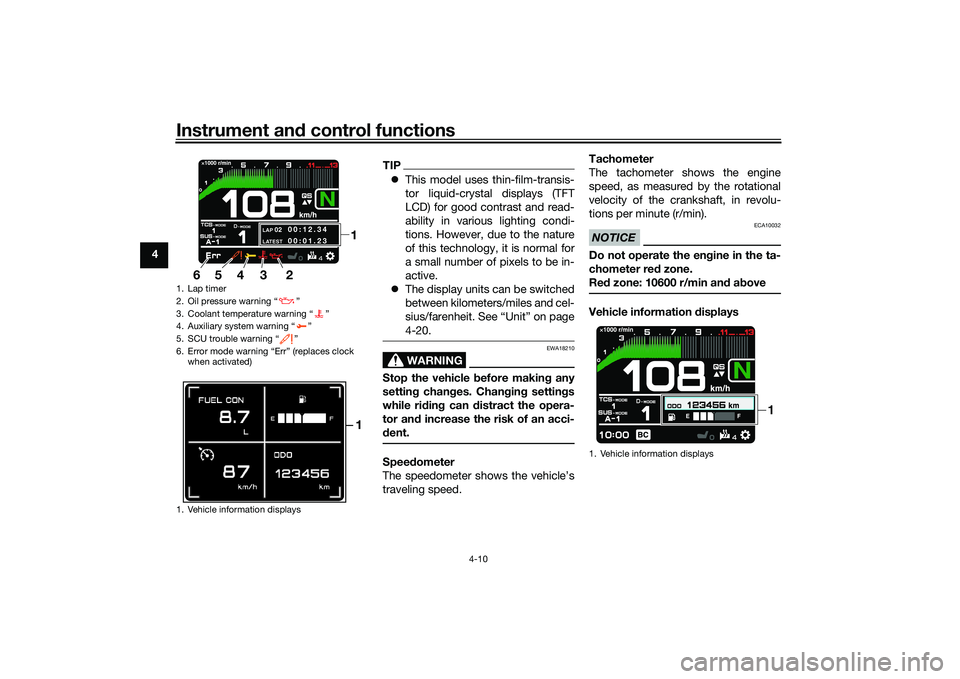
Instrument and control functions
4-10
4
TIP This model uses thin-film-transis-
tor liquid-crystal displays (TFT
LCD) for good contrast and read-
ability in various lighting condi-
tions. However, due to the nature
of this technology, it is normal for
a small number of pixels to be in-
active.
The display units can be switched
between kilometers/miles and cel-
sius/farenheit. See “Unit” on page
4-20.
WARNING
EWA18210
Stop the vehicle before makin g any
settin g chan ges. Chan gin g settin gs
while rid ing can d istract the opera-
tor an d increase the risk of an acci-
d ent.Speed ometer
The speedometer shows the vehicle’s
traveling speed. Tachometer
The tachometer shows the engine
speed, as measured by the rotational
velocity of the crankshaft, in revolu-
tions per minute (r/min).
NOTICE
ECA10032
Do not operate the en
gine in the ta-
chometer red zone.
Re d zone: 10600 r/min an d a boveVehicle information d isplays
1. Lap timer
2. Oil pressure warning “ ”
3. Coolant temperature warning “ ”
4. Auxiliary system warning “ ”
5. SCU trouble warning “ ”
6. Error mode warning “Err” (replaces clock
when activated)
1. Vehicle information displays
LAP
02
LATEST
00:12.3 4
00:01.23
1
4 3
2
6
5
1
1. Vehicle information displays
1
UBAPE0E0.book Page 10 Thursday, December 24, 2020 9:14 AM
Page 36 of 116
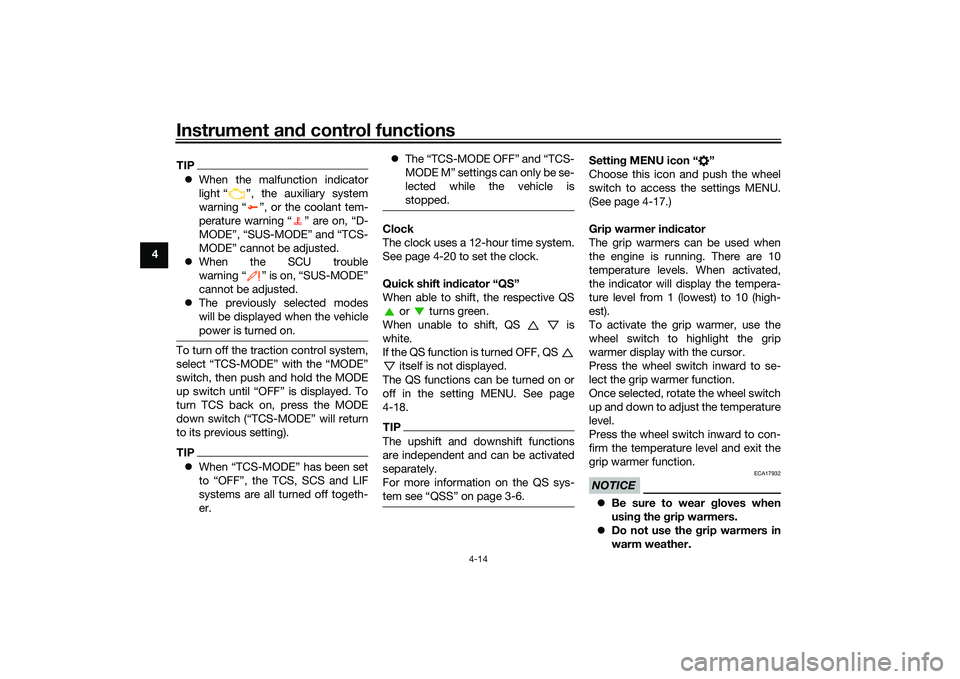
Instrument and control functions
4-14
4
TIP When the malfunction indicator
light “ ”, the auxiliary system
warning “ ”, or the coolant tem-
perature warning “ ” are on, “D-
MODE”, “SUS-MODE” and “TCS-
MODE” cannot be adjusted.
When the SCU trouble
warning “ ” is on, “SUS-MODE”
cannot be adjusted.
The previously selected modes
will be displayed when the vehicle
power is turned on.To turn off the traction control system,
select “TCS-MODE” with the “MODE”
switch, then push and hold the MODE
up switch until “OFF” is displayed. To
turn TCS back on, press the MODE
down switch (“TCS-MODE” will return
to its previous setting).TIPWhen “TCS-MODE” has been set
to “OFF”, the TCS, SCS and LIF
systems are all turned off togeth-
er.
The “TCS-MODE OFF” and “TCS-
MODE M” settings can only be se-
lected while the vehicle is
stopped.
Clock
The clock uses a 12-hour time system.
See page 4-20 to set the clock.
Quick shift in dicator “QS”
When able to shift, the respective QS or turns green.
When unable to shift, QS is
white.
If the QS function is turned OFF, QS itself is not displayed.
The QS functions can be turned on or
off in the setting MENU. See page
4-18.TIPThe upshift and downshift functions
are independent and can be activated
separately.
For more information on the QS sys-
Settin g MENU icon “ ”
Choose this icon and push the wheel
switch to access the settings MENU.
(See page 4-17.)
Grip warmer in dicator
The grip warmers can be used when
the engine is running. There are 10
temperature levels. When activated,
the indicator will display the tempera-
ture level from 1 (lowest) to 10 (high-
est).
To activate the grip warmer, use the
wheel switch to highlight the grip
warmer display with the cursor.
Press the wheel switch inward to se-
lect the grip warmer function.
Once selected, rotate the wheel switch
up and down to adjust the temperature
level.
Press the wheel switch inward to con-
firm the temperature level and exit the
grip warmer function.NOTICE
ECA17932
Be sure to wear gloves when
usin g the g rip warmers.
Do not use the grip warmers in
warm weather.
UBAPE0E0.book Page 14 Thursday, December 24, 2020 9:14 AM
Page 38 of 116
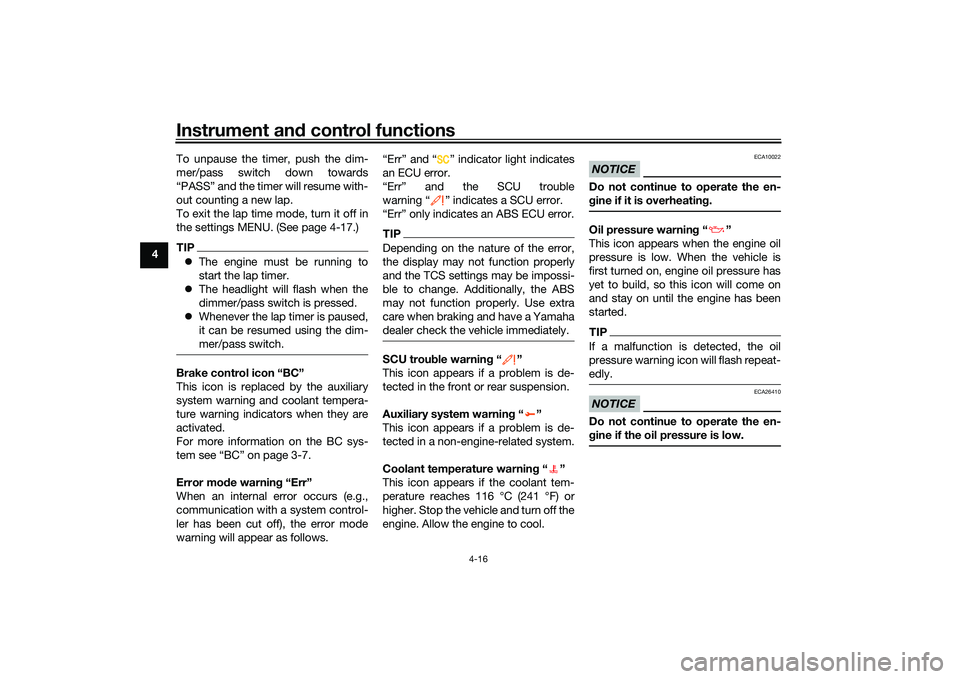
Instrument and control functions
4-16
4 To unpause the timer, push the dim-
mer/pass switch down towards
“PASS” and the timer will resume with-
out counting a new lap.
To exit the lap time mode, turn it off in
the settings MENU. (See page 4-17.)
TIP
The engine must be running to
start the lap timer.
The headlight will flash when the
dimmer/pass switch is pressed.
Whenever the lap timer is paused,
it can be resumed using the dim-
mer/pass switch.Brake control icon “BC”
This icon is replaced by the auxiliary
system warning and coolant tempera-
ture warning indicators when they are
activated.
For more information on the BC sys-
tem see “BC” on page 3-7.
Error mo de warnin g “Err”
When an internal error occurs (e.g.,
communication with a system control-
ler has been cut off), the error mode
warning will appear as follows. “Err” and “ ” indicator light indicates
an ECU error.
“Err” and the SCU trouble
warning “ ” indicates a SCU error.
“Err” only indicates an ABS ECU error.
TIPDepending on the nature of the error,
the display may not function properly
and the TCS settings may be impossi-
ble to change. Additionally, the ABS
may not function properly. Use extra
care when braking and have a Yamaha
dealer check the vehicle immediately.SCU trou
ble warnin g“”
This icon appears if a problem is de-
tected in the front or rear suspension.
Auxiliary system warnin g“”
This icon appears if a problem is de-
tected in a non-engine-related system.
Coolant temperature warnin g“”
This icon appears if the coolant tem-
perature reaches 116 °C (241 °F) or
higher. Stop the vehicle and turn off the
engine. Allow the engine to cool.
NOTICE
ECA10022
Do not continue to operate the en-
g ine if it is overheatin g.Oil pressure warnin g“”
This icon appears when the engine oil
pressure is low. When the vehicle is
first turned on, engine oil pressure has
yet to build, so this icon will come on
and stay on until the engine has been
started.TIPIf a malfunction is detected, the oil
pressure warning icon will flash repeat-
edly.NOTICE
ECA26410
Do not continue to operate the en-
g ine if the oil pressure is low.
UBAPE0E0.book Page 16 Thursday, December 24, 2020 9:14 AM
Page 60 of 116
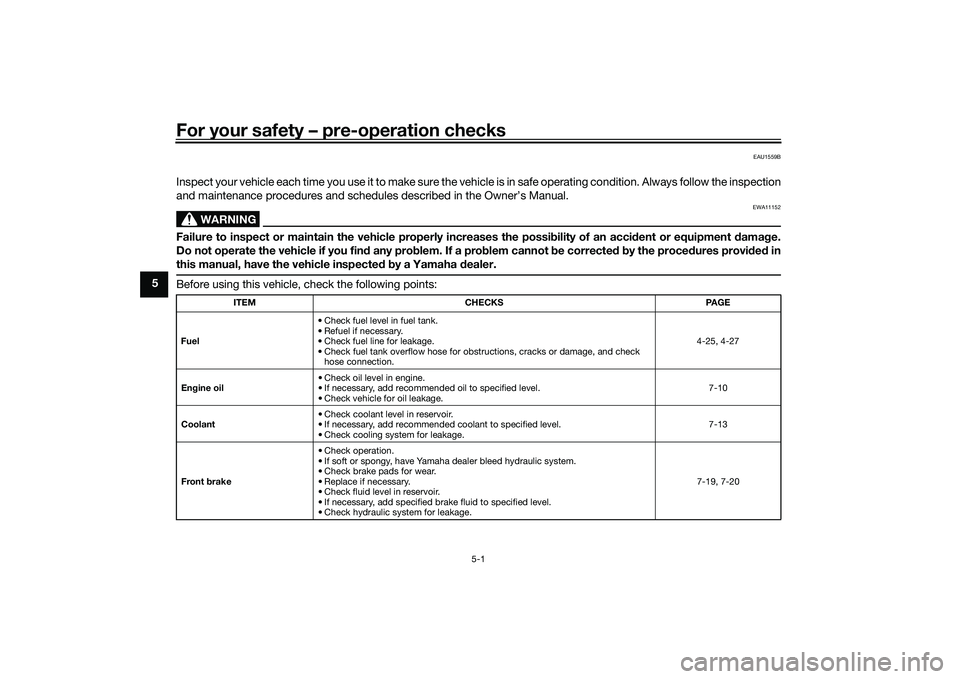
For your safety – pre-operation checks
5-1
5
EAU1559B
Inspect your vehicle each time you use it to make sure the vehicle is in safe operating condition. Always follow the inspection
and maintenance procedures and schedules described in the Owner’s Manual.
WARNING
EWA11152
Failure to inspect or maintain the vehicle properly increases the possibility of an acci dent or equipment damag e.
Do not operate the vehicle if you fin d any pro blem. If a pro blem cannot b e corrected b y the proce dures provi ded in
this manual, have the vehicle inspecte d b y a Yamaha dealer.Before using this vehicle, check the following points:
ITEM CHECKS PAGE
Fuel • Check fuel level in fuel tank.
• Refuel if necessary.
• Check fuel line for leakage.
• Check fuel tank overflow hose for obstructions, cracks or damage, and check
hose connection. 4-25, 4-27
En gine oil • Check oil level in engine.
• If necessary, add recommended oil to specified level.
• Check vehicle for oil leakage. 7-10
Coolant • Check coolant level in reservoir.
• If necessary, add recommended coolant to specified level.
• Check cooling system for leakage. 7-13
Front brake • Check operation.
• If soft or spongy, have Yamaha dealer bleed hydraulic system.
• Check brake pads for wear.
• Replace if necessary.
• Check fluid level in reservoir.
• If necessary, add specified brake fluid to specified level.
• Check hydraulic system for leakage. 7-19, 7-20
UBAPE0E0.book Page 1 Thursday, December 24, 2020 9:14 AM
Page 64 of 116
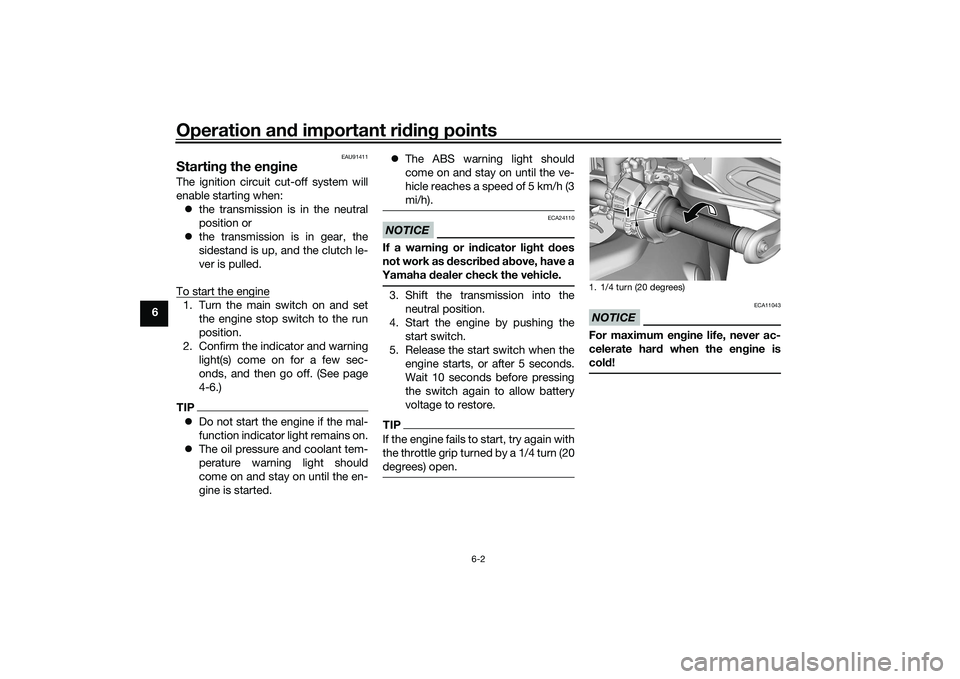
Operation and important rid ing points
6-2
6
EAU91411
Startin g the eng ineThe ignition circuit cut-off system will
enable starting when:
the transmission is in the neutral
position or
the transmission is in gear, the
sidestand is up, and the clutch le-
ver is pulled.
To start the engine1. Turn the main switch on and set the engine stop switch to the run
position.
2. Confirm the indicator and warning light(s) come on for a few sec-
onds, and then go off. (See page
4-6.)TIPDo not start the engine if the mal-
function indicator light remains on.
The oil pressure and coolant tem-
perature warning light should
come on and stay on until the en-
gine is started.
The ABS warning light should
come on and stay on until the ve-
hicle reaches a speed of 5 km/h (3
mi/h).
NOTICE
ECA24110
If a warnin g or in dicator li ght does
not work as d escribed a bove, have a
Yamaha dealer check the vehicle.3. Shift the transmission into the
neutral position.
4. Start the engine by pushing the start switch.
5. Release the start switch when the engine starts, or after 5 seconds.
Wait 10 seconds before pressing
the switch again to allow battery
voltage to restore.TIPIf the engine fails to start, try again with
the throttle grip turned by a 1/4 turn (20
degrees) open.
NOTICE
ECA11043
For maximum en gine life, never ac-
celerate har d when the en gine is
col d!1. 1/4 turn (20 degrees)
1 1 1
UBAPE0E0.book Page 2 Thursday, December 24, 2020 9:14 AM
Page 74 of 116
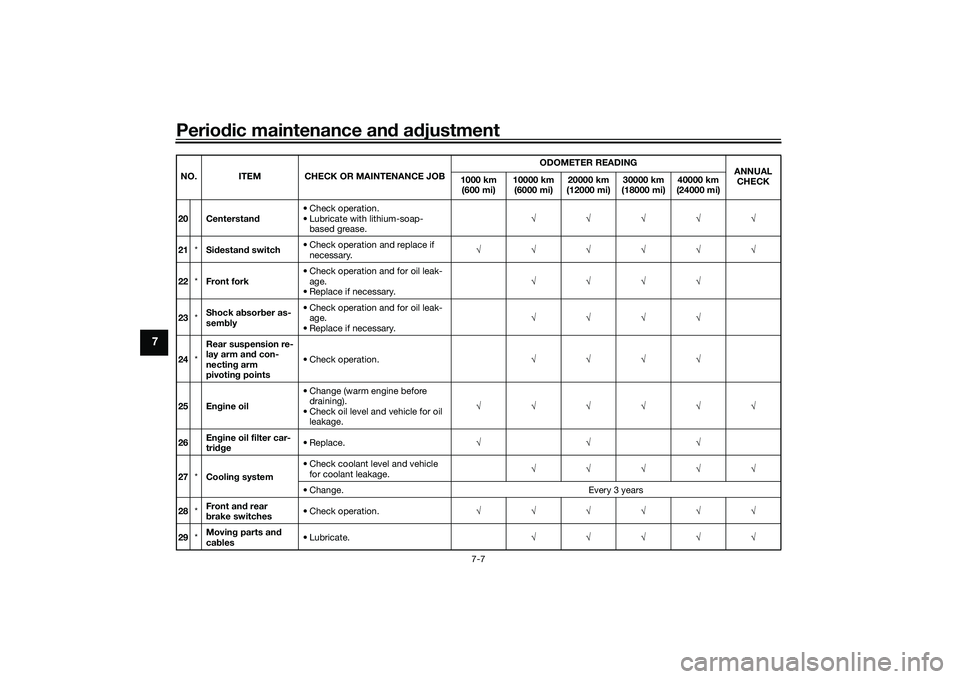
Periodic maintenance an d a djustment
7-7
7
20 Centerstan d• Check operation.
• Lubricate with lithium-soap-
based grease. √√√√√
21 *Sidestan d switch • Check operation and replace if
necessary. √√√√√√
22 *Front fork • Check operation and for oil leak-
age.
• Replace if necessary. √√√√
23 *Shock a
bsor ber as-
sem bly • Check operation and for oil leak-
age.
• Replace if necessary. √√√√
24 *Rear suspension re-
lay arm an
d con-
nectin g arm
pivotin g points • Check operation.
√√√√
25 En gine oil • Change (warm engine before
draining).
• Check oil level and vehicle for oil leakage. √√√√√√
26 En
gine oil filter car-
tri dge • Replace.
√√√
27 *Coolin g system • Check coolant level and vehicle
for coolant leakage. √√√√√
• Change. Every 3 years
28 *Front an
d rear
b rake switches • Check operation.
√√√√√√
29 *Movin
g parts an d
cab les • Lubricate.
√√√√√
NO. ITEM CHECK OR MAINTENANCE JOB
ODOMETER READING
ANNUAL
CHECK
1000 k
m
(600 m i
) 10000 km
(6000 mi) 20000 km
(12000 mi) 30000 km
(18000 mi) 40000 km
(24000 mi)
UBAPE0E0.book Page 7 Thursday, December 24, 2020 9:14 AM